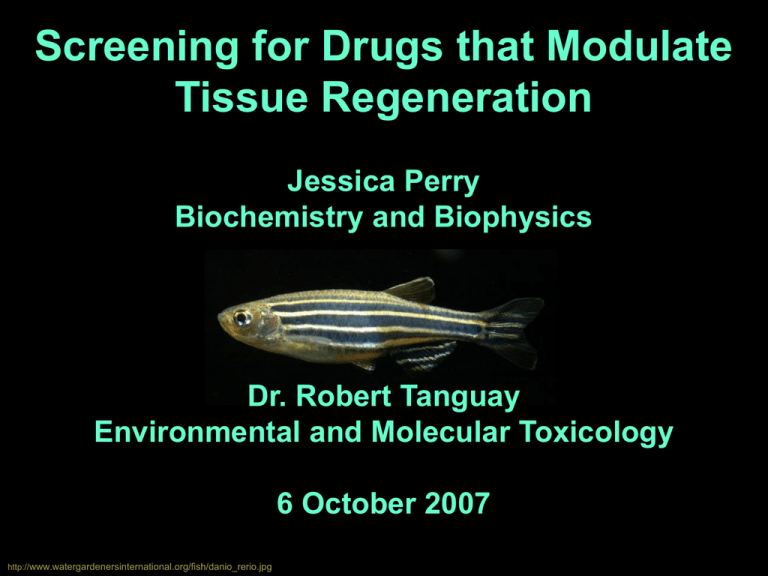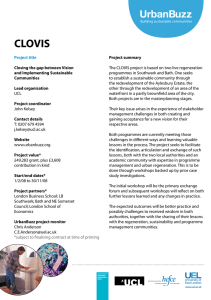Screening for Drugs that Modulate Tissue Regeneration
advertisement

Screening for Drugs that Modulate Tissue Regeneration Jessica Perry Biochemistry and Biophysics Dr. Robert Tanguay Environmental and Molecular Toxicology 6 October 2007 http://www.watergardenersinternational.org/fish/danio_rerio.jpg Background Regenerative Medicine in Myths www.hensleygallery.com Prometheus http://www.exoticindiaart.com/artimages/herakles_sm.jpg Hercules Observations of Regeneration in Animals http://www.bergen.edu/faculty/rdill/Biology_II/Bio_II_lab_Images/planaria.jpg http://pond1.gladstonefamily.net:8080/hydra.jpg http://www.watergardenersinternational.org/fish/danio_rerio.jpg http://www.anfibitalia.it/gallery/gallery.asp?ID=24 http://en.wikipedia.org/wiki/Image:House_mouse.jpg www.richtervideos.com/ images/img00085.jpg Regenerative Medicine Direct Stem Cell Research Indirect Alternative Animal Model With Regenerative Capacity Relevance • • • • Future therapies Further understanding of disease process Political issues with stem cells Alternative animal models of regeneration may prove to be a complement to stem cell research. Research Model- Zebrafish Caudal Fin Regeneration Outgrowth Epithelial Wound Cap Amputation 2 dpa 4 dpa Cellular Migration 11 dpa Blastema Differentiation 0 dpa Proliferation 3 dpa Investigating Zebrafish Fin Regeneration A. Genetic Mutants Important genes during development could not be identified - Lethality. B. Chemical Inhibitors Tight control of chemical exposure TCDD inhibits caudal fin regeneration. 3 dpa DMSO TCDD Chemical Genetics to Identify Essential Molecular Targets During Regeneration. Primary Screening – Schematic Diagram SB 431542 Inhibits Caudal Fin Regeneration 3dpa 3dpa Classifying the Chemical “Hits” Biomarkers for specific regenerative stages Secondary Screening - in situ hybridization mRNA cDNA Insert into TOPO vector PCR to amplify gene Transcription & labeling cDNA in vector transform bacteria multiple copies Linearize DNA Isolate plasmid Grow bacteria (amplify) Dlx5a 24hpa Apply to fixed animal tissue labeled ss antisense probe www.zf-models.org/images/zf_24hpf.jpg Detect expression pattern Secondary Screening – Group the chemicals to different regeneration stages In situ hybridization – Marker analysis Junbl Uncut Junbl 24hpa Raldh2 uncut Raldh2 24hpa Results of Secondary Screen No chemical SB431542 dlx5a dlx5a msxe msxe No chemical raldh2 wnt10a SB431542 raldh2 wnt10a Summary •Used chemical screens to identify small molecules that inhibit regeneration •Developed secondary screens to identify steps in the regeneration network •Grouped chemical “hits” to specific regeneration stages. Acknowledgements Dr. Robert Tanguay Jane LaDu Sumitra Sengupta Lijoy K. Mathew Dr. Kevin Ahern HHMI URISC OSU





